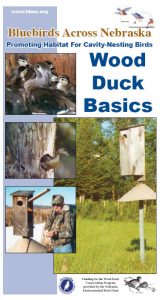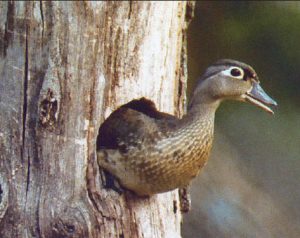Nebraska’s Wood Ducks – Historical Notes and Thoughts
by Roger Strand
With the onset of Europeans, breaking the prairie sod, and control of wild fires – and with an added assist from pioneer tree planters, Nebraska’s waterways have gradually taken on a new look. In the case of the Platte River, another factor favoring riparian tree growth was construction of the Kingsley Dam in the 1930s near Ogallalla. Besides creating Lake McConaughy, it controlled flows. This control, along with de-watering of the river further upstream, has eliminated the massive scouring of the Platte’s banks and channels each spring by ice-laden floodwaters. Pioneer farmers could recall whole islands in the river disappearing, swept downstream along with any young tree seedlings that had chanced to grow.
In the 1980s, I was privileged to hunt waterfowl along a section of the Platte. The hunts were hosted by the Petersons, who are third and fourth generation local landowners and historians. They have carefully preserved the family photos, which document how the scene has changed. Cottonwoods, willows and elms have matured along the banks and associated wetlands. A recent phone call to Todd Peterson confirmed that nesting Wood Ducks have found their bottomlands and now sometimes show up as part of the early season hunting bounty.
Throughout their range, Wood Ducks have shown they can respond dramatically to man’s efforts to improve habitat. Bluebirds Across Nebraska, with the introduction of their Wood Duck Recovery Program, is determined to help accelerate the rate of Wood Duck population gains in the state, including the initiation of new programs where pioneering hens are beginning to appear along ancient waterways. BAN’s Website has more information on how to help.
– Excerpted from Central Flyway News, Jan. 22, 2006
Migration

Wood Ducks move southward from northern breeding areas in early fall. The fall migration of Wood Ducks in Nebraska is from September to December with a median of Oct. 21. The timing of spring migration is not well known due to the overlapping ranges of resident and migratory birds. The spring return of Wood Ducks to Nebraska as documented by Dr. Paul Johnsgard is January 17 to June 7, with a median date of March 28. Half of the 69 sightings made by Dr. Johnsgard appeared to be March 13 to April 8. Wood Ducks begin their migration shortly before sunset and well into the early nocturnal hours flying mostly at night. Birds fly in single pairs or small flocks, stopping several times before reaching their destinations.
Nesting Habitat
The ideal nesting habitat for Wood Ducks includes meandering streams, wetlands, farm ponds and lakes, all with standing timber. Beside providing nest cavities, it offers protection from predators, places to perch and cover from other disturbances. Once the young leave the nest, the female ushers them off to a nearby site where she will rear the brood. This could be an adjacent wetland, pond or oxbow further down the creek. The group travels an average of 2.5 miles and up to 5 miles to locate such a spot. The closer a brood site is to the nesting area, the safer the ducklings.
Nest Box Placement
It is best to locate nest boxes in relatively secluded areas 30-150’ away from the shoreline among timber stands where natural cavities occur. The nest box may also be located over water. Position the opening toward the water and away from the shoreline. This allows ducklings to face the water and cover when they emerge. Since the hen must lead her young to the water soon after hatching, the area between the nest box and water’s edge should be free of obstacles such as roads and fencing. It is important to avoid potential predators. Do not place boxes directly along the shoreline where predators actively stalk prey, and never mount the box to a tree.
Box Plans

Nest boxes should be constructed from weather-resistant wood. Cedar with a minimum thickness of 3/4” is recommended, however 7/8” thickness is preferred. Never apply paints, stains or oils to the inside of any nest box.
The entrance hole should be an oval (3” high and 4” wide) with the bottom of the opening 18” above the bottom of the nest box. Below the entrance on the interior of the nest box a 3” strip of 1/4” mesh hardware cloth should be securely fastened (with cut edges folded back to prevent injury to ducklings) and extend down to the floor. The wire mesh functions as a ladder for the hen and ducklings to climb from the nest to the entrance. A 3” to 4” layer of wood shavings should be placed inside the box prior to each nesting season to protect the eggs.
One side of the box should have a door that swings open, located 6” above the floor. This facilitates monitoring and cleaning. The solid 6” side below the door protects the nest and nestlings when opening the door is required.
Mounting

Never mount a Wood Duck nest box on a tree. Trees are difficult to make predator proof. Don’t mount the box too high either. Wood Ducks will use low mounted boxes. The best practice for mounting a Wood Duck nest box is on a wooden post or steel pole. Using an 8’ post, dig a 2’ deep hole. Place the post in the hole, tamping dirt firmly around its base. Once the post is set securely, bolt the nest box to the post with the bottom of the box entrance 6’ above ground. In wet areas, a steel post is more desirable and a longer length may be needed to securely sink it into the ground. Low mounted nest boxes do not require a ladder to monitor and are much easier to clean and maintain.
Predator Guard
The most effective predator deterrent is the sheet-metal conical predator guard. When constructed to the proper dimensions and snuggly fitted, cone shields provide the best defense against pole-climbing predators. Mount the sheet-metal conical predator guard just below the nest box with the lip of the guard a minimum of 3’ from the ground. With proper placement of the Wood Duck nest box in combination with the conical predator guard, predators can be eliminated and parasitism reduced.
Breeding
The first clutch of eggs is laid between March and April in northern regions. The male will accompany the female in search of a nest site but plays little or no role in site selection. Birds prefer sites that are close to or over water and near to good brood-rearing areas.
The female will lay one egg each day in the morning. The average number of eggs in a clutch is 11-14. These eggs are dull white. After laying each egg, the female will cover the egg with feathers and go off with the male to feed. The female will begin incubation 3-4 days prior to completing the clutch. Incubation averages 30 days and ducklings hatch within 6-18 hours from the time the first egg is pipped. Ducklings will leave the nest during the morning about 24 hours after hatching, once the mother has determined conditions are safe. The mother calls the young from the ground, with each leaping from the cavity opening. The female Wood Duck leads the young away from the nesting site to a brooding area, usually about 2.5 miles away. Young birds fly within 8-10 weeks and the juvenile plumage is almost complete at 70 days.
Nest Dumping
Nest dumping is when extra eggs are found in the nest, the result of several factors including nest predation and lack of available nest sites. Dumping occurs when a female follows another hen to hidden or scarce nest sites during the egg-laying period. Artificial nesting structures are often mistakenly erected close together in highly visible areas. A hen whose nest is dumped with too many eggs may abandon it. Because of this, it is critical to locate nest boxes in isolated locations. If Wood Ducks are rare in the area, it may be necessary to place boxes in open areas initially to encourage use, then moved to more secretive locations as the population increases.
Predators

Predators of Wood Ducks and/or their eggs or ducklings include snakes, raccoons, fox squirrels, mink, bobcats, river otters, red fox, woodpeckers, Blue Jays, European starlings, owls, hawks, falcons, Great Blue Herons and even large fish.
The best practices for prevention of predation include: Never mount a Wood Duck nesting box to a tree or where there are low hanging branches nearby. Use a predator guard on the post and place boxes away from the shoreline in visibly secluded areas. Avoid placing boxes where roads, fences and other obstacles could interfere with ducklings movement to the brooding area. Shrubs and brush along the route to the brooding area provides cover for the brood to evade predators, and the water at both the nesting site and brood area should contain overhanging shrubs and brush, and surface and emergent aquatic plants. Shallow areas are better than deep water.
Monitoring
Pre-season monitoring

Once nest boxes are installed, consider a maintenance and monitoring plan to ensure success of the program. Old nests and those of invasive species, such as European starlings, must be cleaned out. Boxes should be monitored at least once prior to the start of nesting season. Add a fresh layer of sawdust 3-4” deep in the bottom of the box.
Monthly monitoring: Monitoring monthly allows you to collect data on the number of eggs and enables to you inspect for signs of predator activity and nest parasitism. Approach the box quietly and lightly tap on the side to prevent an unexpected surprise if the hen is inside. It is recommended to check the box in the morning when the female Wood Duck is off feeding with the male. If the hen is in the nest, carefully close the door and walk away. Never handle her as it can lead to nest abandonment. Once incubation begins, it is best to avoid opening the box altogether. It’s a matter of timing, but with luck you may observe ducklings as they leave the nest for the first time.
Post season monitoring: After ducklings have left the nest, a visual inspection can offer clues as to the success of the brood. Search within the down and shavings for two main parts of the hatched eggs, the membrane and the cap. The membrane is the thin, white, leathery sack that once held the duckling. It will be collapsed and dried, with a varying number of attached egg shell fragments. Count membranes to determining the number of hatched ducklings. The egg shell caps, about one inch in diameter, served as trapdoors for ducklings and will either be found scattered among debris or still attached to the membrane. It is not uncommon to find one or two unhatched eggs or a dead duckling left behind. Hooded mergansers may lay eggs in the same box with the dominant hen incubating the clutch. Merganser membranes, caps and eggshells are larger, whiter and thicker. Clean out the old nest and replace wood shavings. Leave the box out over winter as it is often used by screech owls and other birds as a winter roost. Wood Duck hens often return the following year to the location where they successfully nested.
For more information, please visit these sites on the Web:
The Wood Duck Society
Nebraska Environmental Trust
